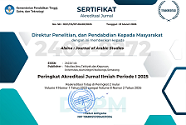Sinonim dalam Berita Agama pada Media Online BBC Arabic
DOI:
https://doi.org/10.21580/alsina.5.1.14084Keywords:
Arabic synonyms, lexical cohesion, religious newsAbstract
This research aims to identify and collect synonyms in religious news about Hajj published in BBC Arabic online media. The method used is a descriptive qualitative, focusing on lexical cohesion analysis involving synonyms. The primary purpose of this research is to understand the variation of synonym usage in the context of religious news about Hajj and to classify the types of synonyms found. Data for this research was collected through documentation, using sources from news published by BBC Arabic. The research results indicate that 14 synonyms were found in the news. These synonyms can be classified into several types, including similar synonyms (Shibhu al-tarāduf), semantic relationship types (Al-taqārub al-dalālī), implication types (Istilzām), paraphrase types), and interpretation. This analysis provides a deeper understanding of the use of synonyms in the context of religious news about Hajj. It shows the richness of the Arabic language in conveying information on the topic. This research has important implications in linguistics, especially in understanding how synonyms are used in specific religious news contexts. This research also significantly contributes to the development of text analysis methodology and Arabic language research in general libraries.
Downloads
References
Brachman, Ronald J. “On the Epistemological Status of Semantic Networks.” In Associative Networks, edited by Nicholas V. Findler, 3–50. Amsterdam: Elsevier, 1979. https://doi.org/10.1016/B978-0-12-256380-5.50007-4.
Collins, Allan M., and M. Ross Quillian. “Retrieval Time from Semantic Memory.” Journal of Verbal Learning and Verbal Behavior 8, no. 2 (1969): 240–47. https://doi.org/10.1016/S0022-5371(69)80069-1.
Djuraid, Husnun N. Panduan Menulis Berita. Malang: UMM Press, 2006.
Endah, Sofie, Fariz Aqila, Zahrotun Nisa, and Ridha Savira Putri Alvan. “Synonyms Analysis in Economic News about the Inflation Crisis in CNN Arabic Online Media.” Journal of Arabic Language Studies and Teaching 3, no. 1 (2023): 75–93. https://doi.org/10.15642/jalsat.2023.3.1.75-93.
Fadli, Muhammad Rijal. “Memahami Desain Metode Penelitian Kualitatif.” Humanika 21, no. 1 (2021): 33–54. https://doi.org/10.21831/hum.v21i1.38075.
ʻUmar, Aḥmad Mukhtār. ʻIlm al-Dalālah. Cairo: ʻĀlam al-Kutub, 1998.
Katz, Jerrold J., and Jerry A. Fodor. “The Structure of a Semantic Theory.” Language 39, no. 2 (1963): 170–210. https://doi.org/10.2307/411200.
Kridalaksana, Harimurti. Kamus Linguistik. Jakarta: Gramedia, 2011.
Laura, Hanady Martha, Mujahidah Fharieza Rufaidah, Nur Hizbullah, and Dedy Ari Asfar. “Makna Leksikal dan Kontekstual Sinonim Kata حزب /Ḥizb/ dalam Berita Politik Media Arab Daring.” In SINASTRA: Prosiding Seminar Nasional Bahasa, Seni, dan Sastra, 1:401–16. Jakarta: Universitas Indraprasta PGRI, 2022. https://proceeding.unindra.ac.id/index.php/sinastra/article/view/6179.
Lyons, John. Semantics. Cambridge: Cambridge University Press, 1977. https://doi.org/10.1017/CBO9781139165693.
Moiseenko, A. V., and L. A. Gunko. “Structure of Contextual Synonymic Rows in Russian and English Newspapers: Ecolinguistic and Contrastive Aspects.” Nauchnyy Dialog 5 (2017): 57–69. https://doi.org/10.24224/2227-1295-2017-5-57-69.
Nasution, Sukma Septian. “The Mass Media’s Language Styles: Its Power and Appropriateness from the Perspective of Systemic Functional Linguistics.” Premise: Journal of English Education 7, no. 1 (2018): 124–34. https://doi.org/10.24127/pj.v7i1.1333.
Nugraha, Aat Ruchiat, Susie Perbawasari, and Feliza Zubair. “Model Komunikasi Pariwisata Yang Berbasiskan Kearifan Lokal.” Jurnal The Messenger 9, no. 2 (2017): 231. https://doi.org/10.26623/themessenger.v9i2.468.
Olimat, Sameer Naser. “Words as Powerful Weapons: Dysphemism in Trump’s Covid-19 Speeches.” 3L The Southeast Asian Journal of English Language Studies 26, no. 3 (2020): 17–29. https://doi.org/10.17576/3L-2020-2603-02.
Palmer, Frank Robert. Semantics. Cambridge: Cambridge University Press, 1981.
Parera, Jos Daniel. Teori Semantik. Jakarta: Erlangga, 2004.
Pateda, Mansoer. Semantik Leksikal. Jakarta: Rineka Cipta, 2010.
Quillian, M. Ross. “Word Concepts: A Theory and Simulation of Some Basic Semantic Capabilities.” Behavioral Science 12, no. 5 (1967): 410–30. https://doi.org/10.1002/bs.3830120511.
Soleh, Mohammad, Ismi Dwi Astuti Nurhaeni, and Sri Hastjarjo. “Women and Media as a Tool to Attract Online News Readers in Indonesia.” International Journal of Multicultural and Multireligious Understanding 7, no. 10 (2020): 138–46. https://doi.org/10.18415/ijmmu.v7i10.2083.
Stout, Daniel A., and Judith M. Buddenbaum. “Media, Religion, and ‘Framing.’” Journal of Media and Religion 2, no. 1 (2003): 1–3. https://doi.org/10.1207/S15328415JMR0201_1.
Sumadiria, AS Haris. Jurnalistik Indonesia Menulis Berita dan Feature Panduan Praktis Jurnalis Profesional. Bandung: Simbiosa Rekatama Media, 2008.
Woods, William A. “What’s in a Link.” In Representation and Understanding, 35–82. Amsterdam: Elsevier, 1975. https://doi.org/10.1016/B978-0-12-108550-6.50007-0.
Yusanti, Imania Putri, Rika Avianty, and Sumarlam Sumarlam. “Kesinoniman Berita Online dalam Situs Komisi Pemberantasan Korupsi (KPK) Edisi Januari-Juni 2019.” In Prosiding Seminar Nasional Linguistik dan Sastra (SEMANTIKS) 2019, 334–43. Surakarta: Universitas Sebelas Maret, 2019. https://jurnal.uns.ac.id/prosidingsemantiks/article/view/39030.
Zeiler, Xenia, and Kerstin Radde-Antweiler. “Introduction to the Special Issue on Journalism, Media and Religion: How News Media Ascribe Meanings to the Terms ‘Sacred’, ‘Secular’ and ‘Authority.’” Journal of Religion, Media and Digital Culture 7, no. 3 (2018): 261–68. https://doi.org/10.1163/21659214-00703001.
Zhang, Zhe, Le Chen, Fengjing Yin, Xin Zhang, and Lixiang Guo. “Improving Online Clustering of Chinese Technology Web News With Bag-of-Near-Synonyms.” IEEE Access 8 (2020): 94245–57. https://doi.org/10.1109/ACCESS.2020.2995516.
Downloads
Published
How to Cite
Issue
Section
License
Copyright
The copyright of the received article shall be assigned to the publisher of the journal. The intended copyright includes the right to publish the article in various forms (including reprints). The journal maintains the publishing rights to published articles. Authors are allowed to use their articles for any legal purposes deemed necessary without written permission from the journal, but with an acknowledgment to this journal of initial publication.
Licensing
In order for Alsina: Journal of Arabic Studies to publish and distribute research articles, the editors need publishing rights (transferred from author to publisher). This agreement relates to the transfer/publishing copyright license to Alsina: Journal of Arabic Studies but the authors still have significant rights to use and share their published articles.
Alsina: Journal of Arabic Studies supports the need for writers to share, disseminate and maximize the impact of their research and their rights on any database. As a journal article writer, you have the right to various uses of your articles, including that by the institution or company where you work. Copyright can be used without the need for special permission. Authors who publish articles in the Alsina: Journal of Arabic Studies have broad rights to use their work for teaching and scientific purposes without requesting permission, including:
- Use by the author for lectures, presentations, or conferences, with distribution of copies to participants;
- Distribution to colleagues for research use;
- Use in compilations of the author's subsequent work;
- inclusion in a thesis or dissertation;
- Reuse of sections or excerpts from articles in other works (with full acknowledgment of the final article);
- Preparation of derivative works (other than commercial purposes) (with full acknowledgment of the final article);
- Voluntary posting on open websites operated by authors’ or writers' agencies for scientific purposes
When submitting a manuscript, authors do so on the understanding that if accepted for publication, the copyright for publishing (publishing right) of the article shall be assigned/transferred to Alsina: Journal of Arabic Studies.
Authors whose articles are accepted for publication will receive confirmation via email and sent a Copyright Transfer Agreement.


 Accreditation
Accreditation 
 In Collaboration with
In Collaboration with 

 Visitors
Visitors  Article Template
Article Template





